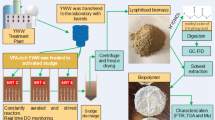Abstract
Recovery of the intracellular bioplastic poly(β-hydroxybutyric acid) or PHB from fed-batch cultured Alcaligenes latus, ATCC 29713, was examined using combinations of chemical and mechanical treatments to disrupt the cells. Chemical pretreatments used sodium chloride and sodium hydroxide. For salt pretreatment the cells were exposed to NaCl (8 kg m−3) and heat (60 °C, 1 h), cooled to 4 °C, and mechanically disrupted. For alkaline treatments, the cells were exposed to sodium hydroxide (0.025–0.8 kg NaOH per kg biomass) and mechanically disrupted at ambient temperature. A combined treatment with sodium chloride (8 kg m−3), heat (60 °C, 1 h), and alkaline pH shock (pH 11.5, 1 min) was also tested. Mechanical disruption employed a continuous flow bead mill (2,800 rpm agitation speed, 90 ml min−1 slurry flow rate, 512 m mean bead diameter, bead loadings of 80% or 85% of chamber volume). Disruption was quantified by protein release. Over most of the disruption period, the release of PHB was approximately proportional to protein release. Regardless of the pretreatment or bead load, the disruption obeyed first order kinetics; hence, the rate of protein release was directly proportional to the amount of unreleased protein. Relative to untreated biomass, pretreatment always produced earlier protein release during milling. Pretreatment with a minimum of 0.12 kg NaOH per kg biomass was necessary to enable complete disruption within three passes (85% bead load). Untreated biomass required more than twice as many passes. Irrespective of the chemical pretreatment, the bead loading strongly influenced the disruption rate which was higher at the higher loading. Alkaline hydrolysis associated PHB loss was observed, but it could be limited to insignificant levels by immediate neutralization of disrupted homogenates.
Similar content being viewed by others
Author information
Authors and Affiliations
Consortia
Additional information
Received: 5 January 1998
Rights and permissions
About this article
Cite this article
Tamer, I., Moo-Young, M. & Y. Chisti. Optimization of poly(β-hydroxybutyric acid) recovery from Alcaligenes latus: combined mechanical and chemical treatments. Bioprocess Engineering 19, 459–468 (1998). https://doi.org/10.1007/PL00009030
Issue Date:
DOI: https://doi.org/10.1007/PL00009030




